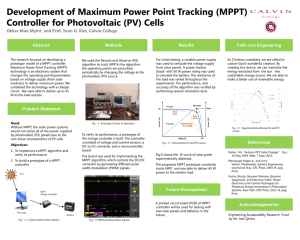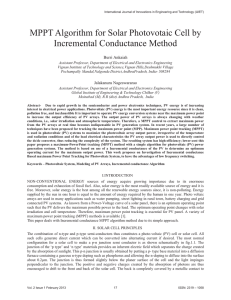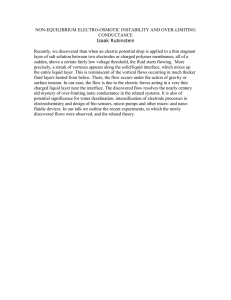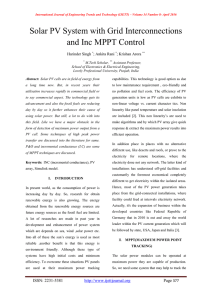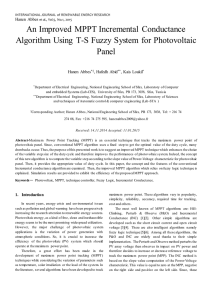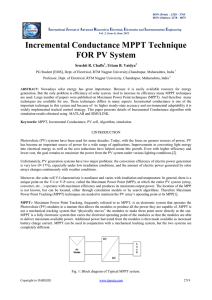Incremental Conductance Based Maximum Power Point Tracking
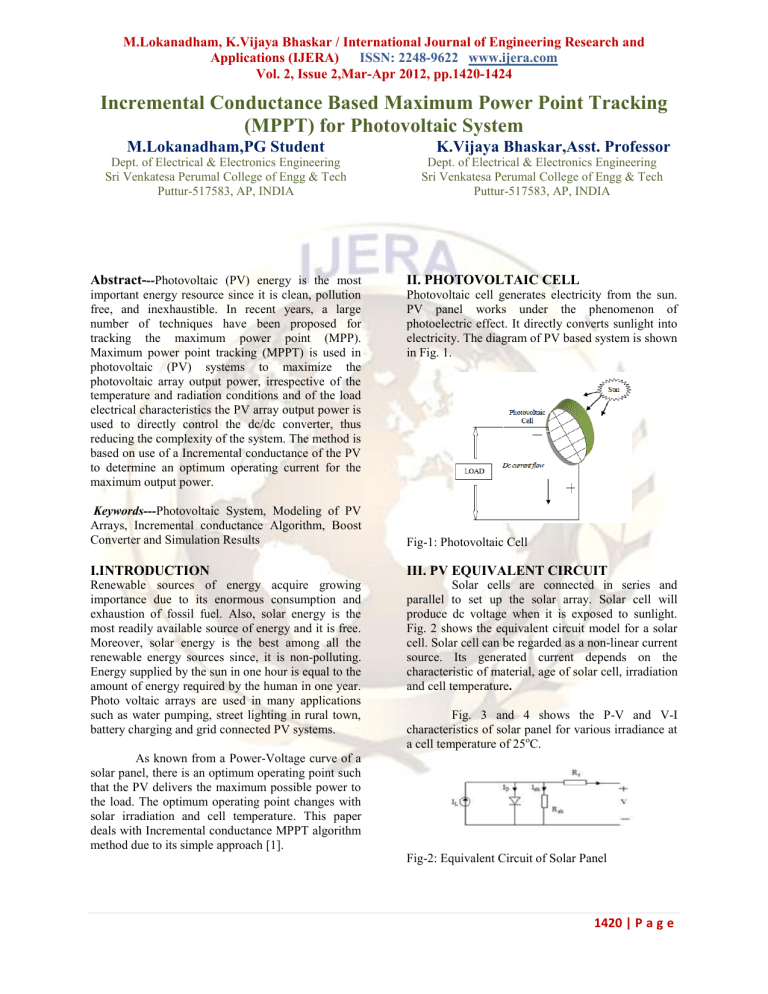
M.Lokanadham, K.Vijaya Bhaskar / International Journal of Engineering Research and
Applications (IJERA) ISSN: 2248-9622 www.ijera.com
Vol. 2, Issue 2,Mar-Apr 2012, pp.1420-1424
Incremental Conductance Based Maximum Power Point Tracking
(MPPT) for Photovoltaic System
M.Lokanadham,PG Student K.Vijaya Bhaskar,Asst. Professor
Dept. of Electrical & Electronics Engineering
Sri Venkatesa Perumal College of Engg & Tech
Puttur-517583, AP, INDIA
Dept. of Electrical & Electronics Engineering
Sri Venkatesa Perumal College of Engg & Tech
Puttur-517583, AP, INDIA
Abstract-
-Photovoltaic (PV) energy is the most important energy resource since it is clean, pollution free, and inexhaustible. In recent years, a large number of techniques have been proposed for tracking the maximum power point (MPP).
Maximum power point tracking (MPPT) is used in photovoltaic (PV) systems to maximize the photovoltaic array output power, irrespective of the temperature and radiation conditions and of the load electrical characteristics the PV array output power is used to directly control the dc/dc converter, thus reducing the complexity of the system. The method is based on use of a Incremental conductance of the PV to determine an optimum operating current for the maximum output power.
Keywords--Photovoltaic System, Modeling of PV
Arrays, Incremental conductance Algorithm, Boost
Converter and Simulation Results
I.INTRODUCTION
Renewable sources of energy acquire growing importance due to its enormous consumption and exhaustion of fossil fuel. Also, solar energy is the most readily available source of energy and it is free.
Moreover, solar energy is the best among all the renewable energy sources since, it is non-polluting.
Energy supplied by the sun in one hour is equal to the amount of energy required by the human in one year.
Photo voltaic arrays are used in many applications such as water pumping, street lighting in rural town, battery charging and grid connected PV systems.
As known from a Power-Voltage curve of a solar panel, there is an optimum operating point such that the PV delivers the maximum possible power to the load. The optimum operating point changes with solar irradiation and cell temperature. This paper deals with Incremental conductance MPPT algorithm method due to its simple approach [1].
II. PHOTOVOLTAIC CELL
Photovoltaic cell generates electricity from the sun.
PV panel works under the phenomenon of photoelectric effect. It directly converts sunlight into electricity. The diagram of PV based system is shown in Fig. 1.
Fig-1: Photovoltaic Cell
III. PV EQUIVALENT CIRCUIT
Solar cells are connected in series and parallel to set up the solar array. Solar cell will produce dc voltage when it is exposed to sunlight.
Fig. 2 shows the equivalent circuit model for a solar cell. Solar cell can be regarded as a non-linear current source. Its generated current depends on the characteristic of material, age of solar cell, irradiation and cell temperature .
Fig. 3 and 4 shows the P-V and V-I characteristics of solar panel for various irradiance at a cell temperature of 25 o
C.
Fig-2: Equivalent Circuit of Solar Panel
1420 | P a g e
M.Lokanadham, K.Vijaya Bhaskar / International Journal of Engineering Research and
Applications (IJERA) ISSN: 2248-9622 www.ijera.com
Vol. 2, Issue 2,Mar-Apr 2012, pp.1420-1424
Equation (1) describes the I-V characteristics of the PV model,
I=IL −𝐼 o(e)
(𝑞(𝑉+𝐼RS )
𝐾𝑇
(𝑞(𝑉+𝐼RS )
𝐾𝑇
(1)
V.INCREMENTAL CONDUCTANCE MPPT
In incremental conductance method the array terminal voltage is always adjusted according to the
MPP voltage it is based on the incremental and instantaneous conductance of the PV module.
I=IL −𝐼 o( 𝑒
(𝑞 (𝑉+𝐼Rs )
𝐾𝑇 -1) −
𝑉+𝐼𝑅𝑠
𝑅𝑠ℎ
(2)
Fig-3: P-V Characteristics of Solar Panel for Various
Irradiance S at a Temperature of 25 o
C
Fig-4: I-V Characteristics of Solar Panel for Various
Irradiance S at a Temperature of 25 o c
IV. SYSTEM DESCRIPTION
The circuit diagram of Photovoltaic system [7],[8] is shown in Fig 5. The PV system is modeled using
Power System Block set under Matlab/ Simulink.
The MPPT algorithm is modeled using mat- lab function System
Fig-5: Block of Photovoltaic System
Fig-6: Basic idea of incremental conductance method on a P-V Curve of solar module
Fig-6 shows that the slope of the P-V array power curve is zero at The MPP, increasing on the left of the MPP and decreasing on the Right hand side of the MPP. The basic equations of this method are as follows. 𝑑𝐼
= − 𝑑𝑉
𝐼
𝑉
At MPP 𝑑𝐼
> −
𝐼
𝑉
Left of MPP 𝑑𝑉 𝑑𝐼 𝑑𝑉
< −
𝐼
𝑉
Right of MPP
(3)
(4)
(5)
Where I and V are P-V array output current and voltage respectively. The left hand side of equations represents incremental conductance of P-V module and the right hand side represents the instantaneous conductance. When the ratio of change in output conductance is equal to the negative output conductance, the solar array will operate at the maximum power point.
VI. INCRIMENTAL CONDUCTANCE
MPPT ALGORITHM
This method exploits the assumption of the ratio of change in output conductance is equal to the negative output Conductance Instantaneous conductance. We have,
P = V I products yields to
∂P/∂V = [∂(VI)]/ ∂V
(6)
Applying the chain rule for the derivative of
(7)
At MPP, as ∂P/∂V=0 (8)
The above equation could be written in terms of array voltage V and array current I as
1421 | P a g e
M.Lokanadham, K.Vijaya Bhaskar / International Journal of Engineering Research and
Applications (IJERA) ISSN: 2248-9622 www.ijera.com
Vol. 2, Issue 2,Mar-Apr 2012, pp.1420-1424
∂I/∂V = - I/V (9)
The MPPT regulates the PWM control signal of the dc – to – dc boost converter until the condition: (∂I/∂V) + (I/V) = 0 is satisfied.
In this method the peak power of the module lies at above 98% of its incremental conductance.
The Flow chart of incremental conductance MPPT is shown below. maximum power tracked under 1000W/m2 insulation and load conditions [4] using MPPT controller in closed loop which is implemented using mat lab function. Here the insulation is 1000W/m2.
According to the results, computed P max
is 1132W, so the tracking efficiency is 96.8%. the proposed method attempts to tracked 1132W out of available maximum power 1169W at 250c and irradiance of
1000w/m2 (750W for without MPPT) the proposed method attempts to tracked 1132W out of available maximum power 1169W at 25
0 c and irradiance of
1000w/m2 (750W for without MPPT). PV-output current, voltage, power wave forms are shown in below.
Fig-7:Incremental conductance MPPT Flow chart
VII.SIMULATION CIRCUIT
Fig-9: P-V Characteristics for Variation due to
Irradiance Change
Fig-8:Simulink Model for Incremental conductance
MPPT
VIII.SIMULATION RESULTS
Fig.15 shows the power of the photovoltaic panel under 1000W/m2 insulation and load conditions in open loop. The maximum power obtained at 1000W/m2 insulation was 780W in the open loop condition. The Fig. 15 shows the
Fig-10: P-V Characteristics for Variation due to
Temperature Change
P-V Characteristics of PV system for variation of irradiance from 400w/ m2 to 1000w/m2 and temperature from 25
0 c to 45 o
C is shown in fig 6 and fig 7.the maximum available power at irradiance of 1000w/m2 and temperature of 25 o c is 1169w
Shown in fig 8,V-I characteristics is also shown in fig 9.
1422 | P a g e
M.Lokanadham, K.Vijaya Bhaskar / International Journal of Engineering Research and
Applications (IJERA) ISSN: 2248-9622 www.ijera.com
Vol. 2, Issue 2,Mar-Apr 2012, pp.1420-1424
Fig-11:P-V Characteristics for 1000w/m2 Irradiance and 25 ⁰ C
Fig-15: PV-Output Power
Fig-12: I-V Characteristics for 1000w/m2 Irradiance and 25 ⁰ C
Fig-13: PV-Output Current
Fig-14: PV-Output Voltage
Fig-16: PV-Output Power of with and without MPPT
IX. CONCLUSION
The paper proposes a simple MPPT method that requires only measurements of Incremental conductance. The proposed MPPT algorithm is called
Incremental conductance Method. However, by using this MPPT method we have increased efficiency by
44%. This method computes the maximum power and controls directly the extracted power from the
PV. The proposed method offers different advantages which are: good tracking efficiency, response is high and well control for the extracted power.
REFERENCES
[1].
Hussein, K.H., Murta ,I.,Hoshino ,T.,
Osakada,M., “ Maximum photovoltaic power tracking: an algorithm for rapidly changing atmospheric conditions
”, IEEE
Proceedings of Generation, Transmission and Distribution, vol. 142, No.1
, 1995.
[2].
E. Koutroulis, et. Al, “ Development of a
Microcontroller-based photovoltaic maximum power tracking control system ”,
IEEE Trans. On power Electron, vol.16, No.
1 , PP.46-54, 2001.
[3].
J.A.Jiang et. Al.,” Maximum Power Tracking for Photovoltaic Power Systems ,” Tamkang
Journal of Science and Engineering, Vol. 8,
No. 2 , pp. 147-153, 2005.
[4].
S. Jain and V. Agarwal, “
A New Algorithm for Rapid Tracking of Approximate
Maximum Power Point in Photovoltaic
Systems” ’ IEEE Power Electronic Letter,
Vol.2, pp. 16-19 , Mar.2004.
1423 | P a g e
M.Lokanadham, K.Vijaya Bhaskar / International Journal of Engineering Research and
Applications (IJERA) ISSN: 2248-9622 www.ijera.com
Vol. 2, Issue 2,Mar-Apr 2012, pp.1420-1424
[5].
Y.Kuo, et. Al., “ Maximum power point tracking controller for photovoltaic energy conversion system ”, IEEE Trans. Ind.
Electron ., Vol.48
, pp. 594-601, 2001.
[6].
Rafia Akhter and Aminul Hoque, “ Analysis of a PWM Boost Inverter for Solar Home
Application ”, Proceedings of World
Academy Of Science, Engineering And
Technology Volume 17 December 2006
ISSN 1307-6884.
[7].
Huan-Liang Tsai, Ci-Siang Tu and Yi-Jie
Su, “ Development of Generalized
Photovoltaic Modeling Using
MATLAB/Simulink “ , Proceedings of the
World Congress on Engineering and
Computer Science 2008 WCECS 2008,
October 22-24, 2008, San Francisco, USA
[8].
FranciscoM.Gonzalez-Longatt, “ Model of
Photovoltaic Module in MatlabTM ”, 2DO
CONGRESO IBERO AMERICANO DE
ESTUDIANTES DE INGENIERIA
ELECTRICA, ELECTRONICA
COMPUTACION(II CIBELEC 2005).
Y
1424 | P a g e
